Shining Light on Visual Distress Signals
Foundation Findings #54 - September 2015
Minimum Requirements and Maximum Safety
Outfitting your boat is generally a personal preference, limited only by imagination and budget. However, most people’s approach to selecting safety gear for the boat is limited to purchasing the required “six of these, three of those, and one of that” … and they’re done. The best boater is one who is prepared for the worst scenario and sometimes redundancy in preparation makes all the difference.
Remember, Coast Guard minimum equipment requirements are just that - minimums! There is no rule that says you can’t purchase a quantity greater than what’s required or additional safety equipment that’s not required. A properly registered DSC VHF radio, a working bilge pump, and a modern distress signaling device are just three that come to mind.
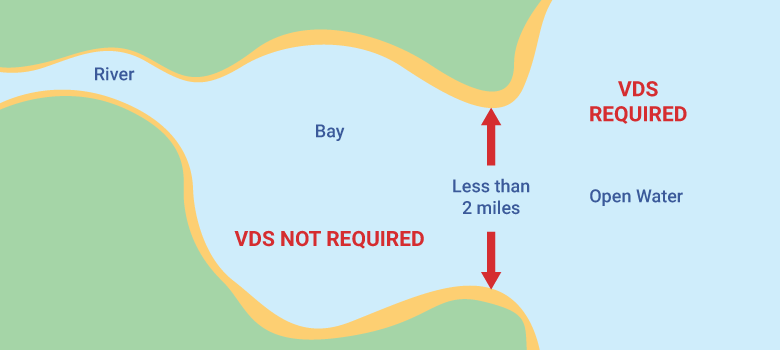
Having Visual Distress Signals (VDS) aboard is a requirement for most recreational boaters. The Coast Guard specifies the type and quantity that’s required and when they can be used. Typically, pyrotechnic devices (or hand-held flares) are what most boaters purchase to meet the requirement. For those that boat inland VDS may not be required, but having some way to signal an emergency just makes sense.
Traditional and Non-Traditional Visual Distress Signals
In September 2015, the BoatUS Foundation set out to evaluate some new-to-the-market emergency visual distress signal devices. Eight devices, only four of which are Coast Guard complaint, were compared to each another and to a common Coast Guard-approved hand-held signal flare which we used as our control. The products were grouped into three categories; hand-held pyrotechnic flares, battery-operated LED lights, and laser signaling devices. Some of the products were designed for both day and night signaling. However, most were designed for nighttime only use, so we evaluated all products after dusk.
| Manufacturer | Model | Type | Color | Duration | Price - Retail Search | USCG - Compliant |
|---|---|---|---|---|---|---|
| Orion Control | Red Locator Flares | PYRO | Red | 3 minutes (observed) | $8.50 per unit (sold in 4-pack) | Yes |
| Orion SOLAS | SOLAS MK8 Red Flare | PYRO | Red | 1 minutes (observed) | $23.99 per unit (sold individually) | Yes |
| ACR Artex | Aurora Distress Signal Flare | PYRO | Red | 1 minutes (observed) | $12.66 per unit (sold in 3-pack) | Yes |
| Odeo Flare, Ltd | ODEO M3 Electronic Flare | LED | Red | 5 hours peak (stated) | $189 (3 "AA" batteries included) | No |
| Ocean Signal | RescueMe EDF-1 | LED | Red | 2 hours peak (stated) | $133 (proprietary battery included) | No |
| North American Survival Systems | EF-20A-1 Lightning Flare | LED | White | 15 hours peak (stated) | $89 (2 CR123 battery included) | No |
| Sirius Signal made by Weems & Plath | SOS Distress Light | LED | White | 6 hours peak (stated) | $99 (3 "C" batteries included) | Yes |
| Greatland Laser | Green Greatland Laser Pointer | LASER | Green | 5 hours total (stated) | $189 (CR123 battery included) | No |
| Greatland Laser | Red Rescue Laser Flare | LASER | Red | 40 hours total (stated) | $99 (CR123 battery included) | No |
Procedures: All products were used in accordance with their directions. Of the products that required batteries, installation was straightforward. All products were current generation at the time of testing, and the pyrotechnic flares were recently manufactured with expiration dates well into the future.
Our approach to evaluating the devices was 100% observational. We did not use dark boxes or light meters to validate product claims, although that data can be obtained by contacting each manufacturer. Instead, we used volunteers to record their observations using a brightness scale of 1-10 with 10 being the brightest.
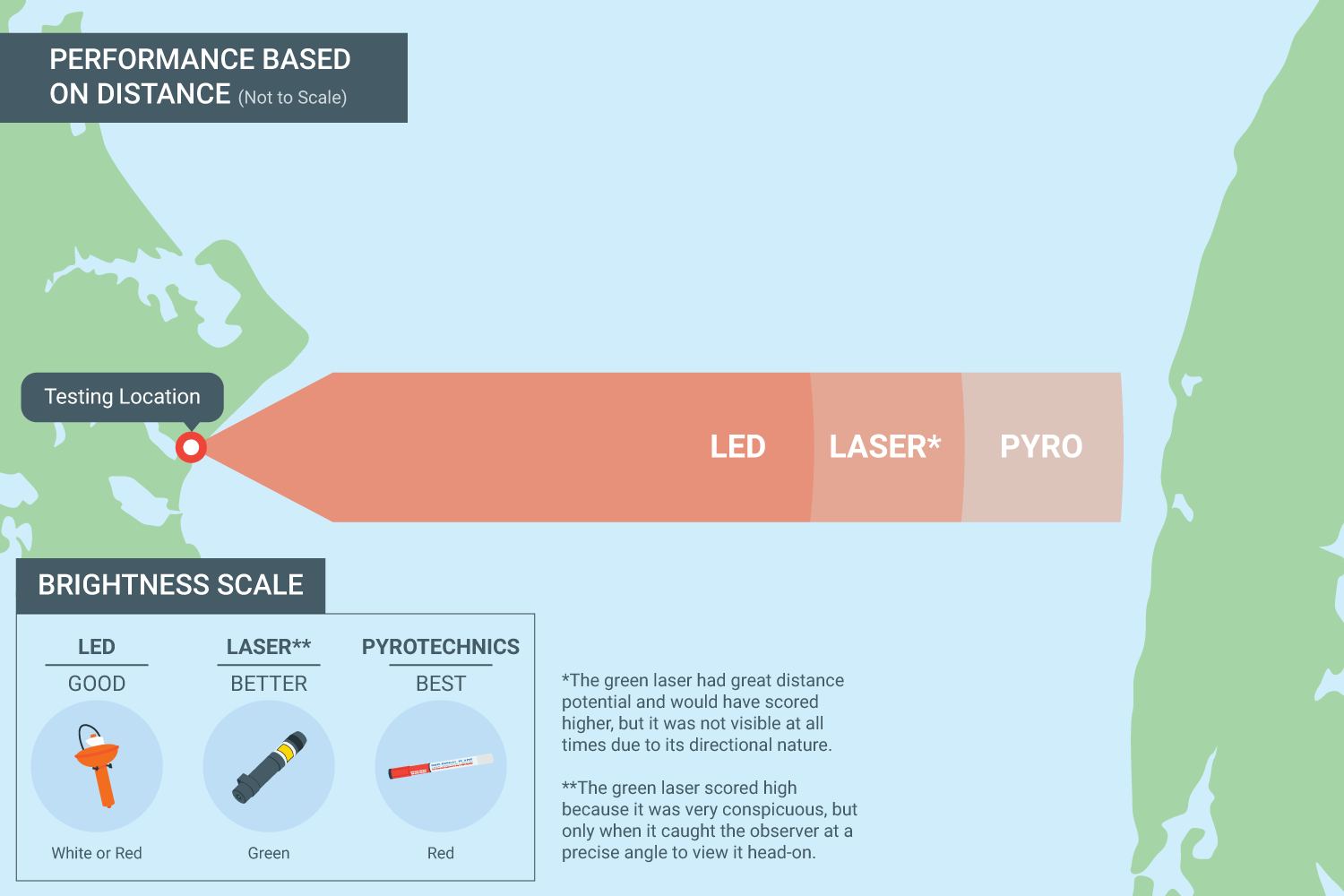
Beach Observers: For the majority of testing, we placed observers on an isolated sandy beach just a few feet above sea level. Foundation staff members loaded up a 25’ workboat with the signal devices and anchored the boat one mile away from the beach. The devices were then illuminated, one at a time, and observers rated them. This test was repeated again at both three and five miles.
At each distance interval, the standard red Orion hand held flare (the control) was always the first illuminated. It was given a default score of "5." Each device was then compared to the control, and scored as the same, more, or less in terms of brightness. At each distance, the other non-control devices were shown in random order to avoid observational bias.
Boat Observers: The fourth test conducted was dubbed the Tiki-Torch Test. For this test, we had the beach crew illuminate all 9 devices and had the boat crew rank them in terms of brightness at one mile away. Each device was affixed to a bamboo pole that was inserted into the sand so that the device was roughly eye-level. The poles were set 25' apart with a tester placed behind each one. On command, all beach crew testers illuminated their device so the observers on the boat could see them all at once in order to make a direct, side by side comparison. We included these findings in our final product rankings.
Weather to Test: The evening we conducted our tests was a still, moonlit night on the Chesapeake Bay - perfect for boating. But was it the best for testing? Since we didn’t have a choice in weather, we proceeded as planned and felt confident that testing these devices in real world conditions with other boat traffic and the backscatter of other lights would really put the products to the test. In the absence of a moon, and in total darkness, we are confident these devices would perform even better.
Pyrotechnic Hand Held Flares - Brightness Award
Of the visual distress signals on the market, the red Coast Guard approved hand held flares for day and nighttime use are the most widely available. They are often packaged in multiples of three to meet minimum Coast Guard carriage requirements. However, some are sold individually so you can purchase the exact quantity you desire in excess of minimum requirements. All three hand held flares evaluated were Coast Guard approved and burned very bright, eclipsing all other products in our tests in terms of brightness.
Hand held pyrotechnic devices, however, have their drawbacks. For example, they expire 42 months after manufacture and must be replaced. And when it comes time to replacement, a disposal conundrum exists since they must be treated as hazardous material. They are also very hot when ignited and can burn skin and clothes. In addition, the sparks and slag emitted can damage your boat, life raft or life jacket if handled improperly. Flares demand your full attention when using them which means you can’t tend to other matters, such as assisting other passengers or hailing a May Day.
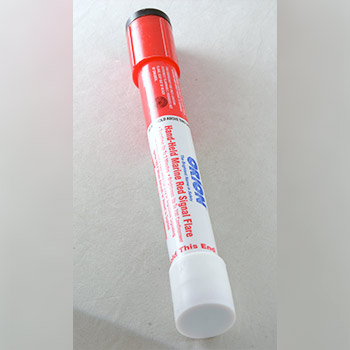
Red Orion Locator Flare
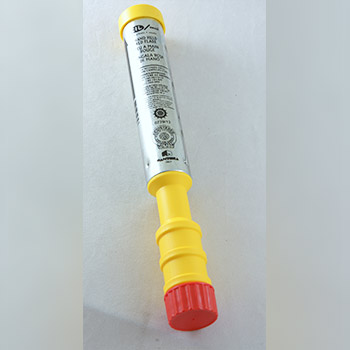
Red Orion USCG/SOLAS

Red ACR Aurora
The newest product in this category is the ACR Aurora hand flare which claims to be over 21 times brighter than some of the hand held flares on the market. However, the Orion SOLAS flare (which stands for Safety of Life at Sea – a rigorous standard set by the International Maritime Organization for serious offshore safety equipment) burned extremely bright as well. Both the ACR Aurora and the Orion SOLAS scored about the same in our tests. These products use magnesium and burned hotter and brighter than the standard Orion flare we used as a control. In fact, these flares were the only two products that required our testers to shield their eyes.
The ACR Aurora also claimed it will ignite and burn under water. We didn’t test that feature but wondered if the benefit is you could drop them in the water for detection by search and rescue personnel from the air, keeping your hands free to tend to the emergency situation at hand.
Foundation Finidings Video: Pyrotechnics
Our biggest disappointment with these devices is burn time. The standard Orion flare burns for three minutes and the ACR and Orion SOLAS burn for only one minute. That means if you carry only the minimum required quantity, you would have just a few minutes of total signaling time. We would certainly recommend you have more than three non-expired flares aboard, or keep some expired flares as a back up to add to your inventory, as long as they are clearly labeled.
Bright Spots: Extremely bright, widely recognized as a distress signal, elicits response
Dim View: Short burn time, expire after 42 months, potentially dangerous, disposal challenge
LED Emergency Distress Lights - Duration Award
Flashlights and personal strobe lights have used LED bulbs for years. As bulb and battery technology have improved, they have gotten brighter, draw less power and are used in just about everything from lights on automobiles to traffic signals. Now, LED lights are being used in emergency signaling devices, some of which have been designed to mimic the light output of a traditional hand held flare or signal a steady S-O-S for hours on end.
Foundation Finidings Video: LEDs
LED bulbs can vary in intensity and frequency and come in just about any color. However, only red and white LED lights were used in the four products tested. This is not surprising since these are the only two colors recognized as distress by the US Coast Guard, the related Code of Federal Regulations and the international community in general.
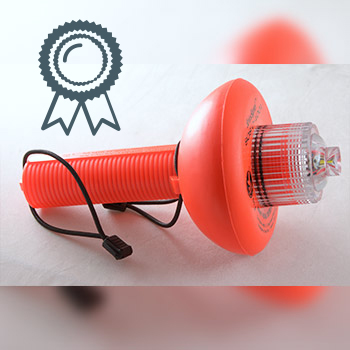
USCG-Approved White Sirius Signal SOS Distress Light
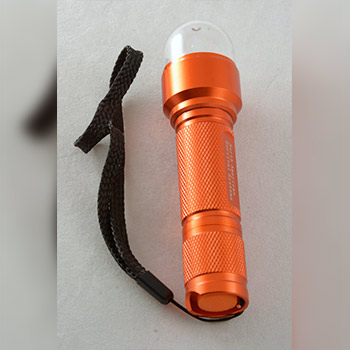
White North American Survival Systems Flare
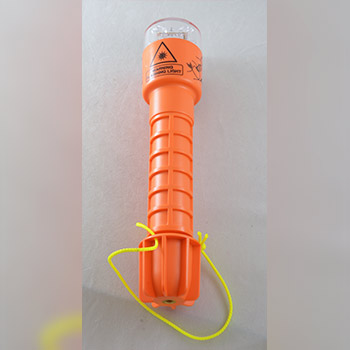
Red Odeo M3 Electronic Flare
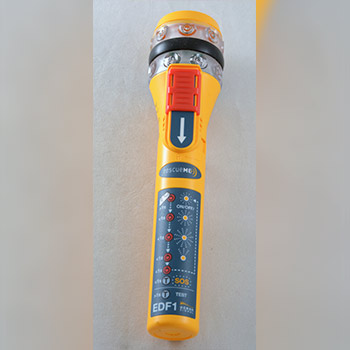
Red Ocean Signal Electronic Flare
Of the four LED lights, only the white Sirius Signal SOS Distress Light, manufactured by Weems & Plath, is Coast Guard compliant. Simply put, this is the only device (electronic or otherwise) that can take the place of pyrotechnic flares. Their marketing is compelling – "Never Buy Flares Again". This device flashes a steady white SOS signal for hours. It is shaped like a flashlight and has a foam collar so it floats. Or, you can hoist it in your boat’s rigging or place it in the rod holder so there’s need to hold or point it. Weems & Plath calls this a "non-participatory device", meaning you don’t have to tend to it - just turn it on and go about tending to the situation at hand.
In our opinion, it would be nice if this light were significantly brighter, but we understand it has been made to precise Coast Guard standards to meet the exact definition of an Electric Distress Light; no more, no less. The other white light evaluated was the Lightning Flare made by North American Survival Systems. It too was shaped like a small flashlight with a clear hemispherical dome. It was rated similarly to the Sirius light in our tests but it needed to be pointed to be the most effective. It doesn’t float, has no additional features and is not Coast Guard compliant. Because of its size and rugged design, it would be a good device to have as a personal flare or to keep in your foul weather pocket.
The Odeo and Ocean Signal are red LED distress signals. The Odeo uses a random flashing frequency that gives it the illusion of a flickering flare or flame. The Ocean Signal has four different brightness settings, and of course we tested only the most intense of these. At this setting, it performed slightly better than the other LED devices, red or white. Unfortunately, at the highest setting, the battery consumption is greatest and being a proprietary battery it can’t be purchased without some searching online.
The LED lights in our tests had tremendous overall duration, lasting hours. We didn’t run down any of the batteries and didn’t need to refresh them the entire evening. If you are looking for a distress signal that puts out a continuous light or an SOS signal, these devices are definately worth consideration and should be part of every ditch kit. If you select the Sirius Signal to take the place of traditional flares, it comes with an orange and black distress flag to meet the daytime requirement. Overall, the red LED lights performed slightly better than white in our tests but neither was as bright as the pyrotechnic devices.
Bright Spots: Long battery life, environmentally safe, compact, priced reasonably
Dim View: Most not Coast Guard compliant*, not as conspicuous as flares, range is less than a flare, can be confused with other lights or lost in backscatter (*the SOS Distress Light is the only electronic visual distress signal that is Coast Guard compliant)
Laser Signaling Devices - Distance Award
When the BoatUS Foundation tested flares in 2008, our observers were impressed with the Red Greatland Laser Light and the Green Greatland Laser Flare. Their packaging promised hours of continuous operation with a range of up to 20 miles for the red unit and up to 30 miles for the green unit. A range of this distance would easily reach across the Grand Canyon and from the base of Mt. Everest to the top, under ideal atmospheric conditions of course!
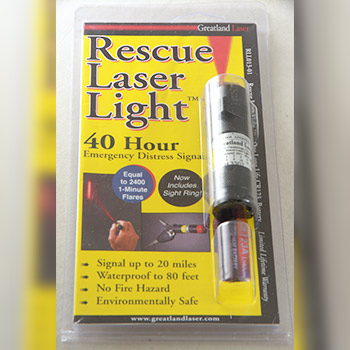
Red Greatland Laser
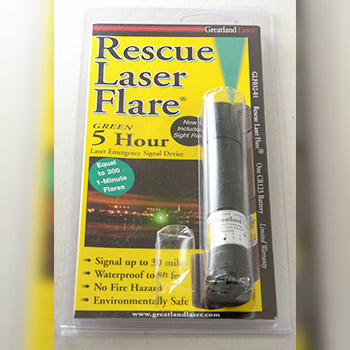
Green Greatland Laser
Little has changed with the two Greatland Laser products since we last tested them. They are still the same small size, not much bigger than a roll of Life Savers candy and still rely on only one small CR123 lithium battery. In fact, the only update we could determine was the addition of a sight ring that helped users more accurately aim the device.
These lasers are not actually dot pointers. Rather they emit a beam that fans out and widens the further it is from the target. The green flare appears to have a different lens aperture so the beam fanned out more than the red. At five miles away, the green flare was still going strong, but the red was showing some weakness. We wish we could have tested the 30 mile claim but we just didn’t have the necessary nautical distance nor did we think to include a large 30 mile circumference when we filed our activity permits with the Coast Guard.
A laser flare takes some considerable concentration to use. Once testers got the hang of pointing it, our observers were absolutely stricken by the conspicuous nature of the light signal. It could not be mistaken for another a boat’s running light or a navigation aid. Still, you need to point or aim the laser at a potential rescuer since it does not emit light an all-around light like every other device we evaluated.
Foundation Finidings Video: Lasers
The red and green laser devices use a Class 3R laser and direct eye exposure is to be avoided. However, a rescue laser can be used safely to signal an aircraft. A law exists making it a felony to aim a laser pointer at an aircraft, but specifically exempts an individual using a laser device to send an emergency distress signal. Protocols require commercial pilots to report all laser strikes and Coast Guard sources report that SAR cases are to be terminated if a laser reaches the cockpit of a Coast Guard aircraft while in flight.
Laser flares are something you should consider adding as part of your personal safety gear since they are small and compact. They have a range greater than any other visual distress signal and when all other things fail, the laser flare might just give you the best last chance.
Bright Spots: Extremely long range, very conspicuous when sighted, long battery life, compact
Dim View: Not Coast Guard compliant, must be aimed with some precision, pilots may veer away from a laser signal to avoid potential temporary blindness

